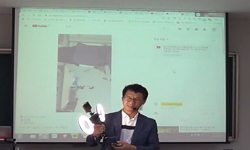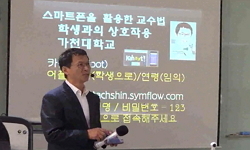The rapid development in information and communication technology has resulted in a significant shift in today's school environment. Utilizing a wide range of new communication media such as the web-based Cyber Campus is now one of the most popular ph...
http://chineseinput.net/에서 pinyin(병음)방식으로 중국어를 변환할 수 있습니다.
변환된 중국어를 복사하여 사용하시면 됩니다.
- 中文 을 입력하시려면 zhongwen을 입력하시고 space를누르시면됩니다.
- 北京 을 입력하시려면 beijing을 입력하시고 space를 누르시면 됩니다.

학습자 간 상호 작용을 위한 사이버 캠퍼스 운영 사례 : 역사 교재 연구 및 지도법을 중심으로 = How to Use the Cyber Campus for Mutual Interaction Among Students in a History Education Class
한글로보기https://www.riss.kr/link?id=A76491077
- 저자
- 발행기관
- 학술지명
- 권호사항
-
발행연도
2009
-
작성언어
Korean
- 주제어
-
KDC
374.05
-
등재정보
KCI등재
-
자료형태
학술저널
-
수록면
153-170(18쪽)
- DOI식별코드
- 제공처
- 소장기관
-
0
상세조회 -
0
다운로드
부가정보
다국어 초록 (Multilingual Abstract)
Students are not bound by time and place anymore. Especially when considering the traditional time pressure of lectures held on campus in a lecture room, the nearly limitless chances of presenting one's ideas about the issues from lectures is a truly attractive side of e-based discussion boards. Another essential notion of the Cyber Campus is that it is a place where all participants of the class can freely make mutual interactions. While raising and discussing issues of interest, they share their opinions and explore each other's thoughts. It is a self-initiative academic engagement with all other classmates, including the instructor. For web-based learning to be successful in pursuing its educational goals, the element of “interaction” is considered to be crucial amongst many others.
This study is a case study of one Cyber Campus class which was operated under a special effort to bring about the mutual interaction among students. Students became preparatory teachers and had a practice class in front of their classmates. After this on-campus lecture room activity, students were to return to Cyber Campus where they could post their feedback and elaborations for the case of the presenters. Besides, the accumulation of various kinds of multimedia teaching materials turned into a valuable database that could be useful in developing future teaching models.
The rapid development in information and communication technology has resulted in a significant shift in today's school environment. Utilizing a wide range of new communication media such as the web-based Cyber Campus is now one of the most popular phenomena to be found. The instant advantage of the Cyber Campus is in its user-friendly accessibility.
Students are not bound by time and place anymore. Especially when considering the traditional time pressure of lectures held on campus in a lecture room, the nearly limitless chances of presenting one's ideas about the issues from lectures is a truly attractive side of e-based discussion boards. Another essential notion of the Cyber Campus is that it is a place where all participants of the class can freely make mutual interactions. While raising and discussing issues of interest, they share their opinions and explore each other's thoughts. It is a self-initiative academic engagement with all other classmates, including the instructor. For web-based learning to be successful in pursuing its educational goals, the element of “interaction” is considered to be crucial amongst many others.
This study is a case study of one Cyber Campus class which was operated under a special effort to bring about the mutual interaction among students. Students became preparatory teachers and had a practice class in front of their classmates. After this on-campus lecture room activity, students were to return to Cyber Campus where they could post their feedback and elaborations for the case of the presenters. Besides, the accumulation of various kinds of multimedia teaching materials turned into a valuable database that could be useful in developing future teaching models.
국문 초록 (Abstract)
본 연구는 학습자 간의 상호 작용을 중심으로 사이버 캠퍼스를 운영한 사례를 연구한 것이다.
학생들은 예비 교사가 되어 모의 수업을 발표한 후 사이버 캠퍼스의 토론방을 통해 자기 성찰의 기회는 물론, 동료들에게 다양한 피드백을 받을 수 있었다. 한편, 역사교과는 그 교과의 특성상 다양한 멀티미디어 자료 활용이 요구된다. 이를 위해 학생들이 발표에 활용하기 위해 창의적으로 만든 자료들은 사이버 캠퍼스를 통해 하나의 DB로 구축되었다. 이러한 과정을 통해 학생들은 사이버 캠퍼스를 통한 상호 작용의 효용성을 경험할 수 있었다.
정보 통신 기술의 발달은 학교 교육 환경의 변화를 유도하였다. 교육 활동은 첨단 매체를 활용함으로써 교수-학습의 방법과 형태에 있어 커다란 변화를 가져왔고, 그 활동 무대를 사이버 공...
정보 통신 기술의 발달은 학교 교육 환경의 변화를 유도하였다. 교육 활동은 첨단 매체를 활용함으로써 교수-학습의 방법과 형태에 있어 커다란 변화를 가져왔고, 그 활동 무대를 사이버 공간으로까지 확대하였다. 사이버 공간을 활용한 교육 체제의 대표적 유형이 사이버 캠퍼스이다. 사이버 캠퍼스는 학습자들이 컴퓨터와 통신망을 활용하여, 시·공간적 제약을 뛰어넘는 쌍방향 학습을 가능하게 한 새로운 학습 공간이다. 뿐만 아니라, 사이버 캠퍼스는 학습자들이 상호 소통을 통해 유용한 정보와 지식 체계를 연결하여 주고받을 수 있는 공간으로 교실을 형성하는 자기 주도적 활동이 이루어지는 곳이다. 사이버 교육이 그 목적 한 바 교육적 성과를 효과적으로 거두기 위해서는 다양한 변인이 작용하는데, 그중에서도 최근 학계에서 활발히 논의되고 있는 요인이 ‘상호작용’이다.
본 연구는 학습자 간의 상호 작용을 중심으로 사이버 캠퍼스를 운영한 사례를 연구한 것이다.
학생들은 예비 교사가 되어 모의 수업을 발표한 후 사이버 캠퍼스의 토론방을 통해 자기 성찰의 기회는 물론, 동료들에게 다양한 피드백을 받을 수 있었다. 한편, 역사교과는 그 교과의 특성상 다양한 멀티미디어 자료 활용이 요구된다. 이를 위해 학생들이 발표에 활용하기 위해 창의적으로 만든 자료들은 사이버 캠퍼스를 통해 하나의 DB로 구축되었다. 이러한 과정을 통해 학생들은 사이버 캠퍼스를 통한 상호 작용의 효용성을 경험할 수 있었다.
목차 (Table of Contents)
- I. 서론
- II. 사이버 교육의 현황 및 연구 동향
- 1. 사이버 교육의 변천
- 2. 연구 동향
- III. 상호 작용을 중심으로 한 사이버 캠퍼스 운영 사례
- I. 서론
- II. 사이버 교육의 현황 및 연구 동향
- 1. 사이버 교육의 변천
- 2. 연구 동향
- III. 상호 작용을 중심으로 한 사이버 캠퍼스 운영 사례
- 1. 수업 환경 만들기
- 2. 교수자-학습자 간 상호 작용 사례
- 3. 학습자 간 상호 작용 사례
- 4. 평가 및 제언
- IV. 결론
- 참고문헌
- Abstract
동일학술지(권/호) 다른 논문
-
- 이화여자대학교 교과교육연구소
- 박인숙
- 2009
- KCI등재
-
정의 공동체 접근(Just Community Approach)에 대한 도덕 교육적 고찰
- 이화여자대학교 교과교육연구소
- 박병춘
- 2009
- KCI등재
-
- 이화여자대학교 교과교육연구소
- 김연희
- 2009
- KCI등재
-
- 이화여자대학교 교과교육연구소
- 조미숙
- 2009
- KCI등재




 RISS
RISS 스콜라
스콜라







